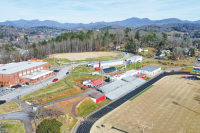Pigeon and Cheoah welcome back long-lost fish and mussels
Encouraged by the success of experimental stockings during the last three years, biologists with the N.C. Wildlife Resources Commission are continuing their efforts to restore fish and mussels in the Cheoah and Pigeon rivers.
They are using aquatic species propagated in hatcheries as well as some moved from other streams.
The restoration work reintroduces aquatic animals into waters where they were once found in abundance. So far this year, biologists have placed several thousand fish and mussels in both rivers.
While most of these reintroductions were accomplished by collecting large numbers of relatively common fishes from places where they were abundant and releasing them into the Pigeon, some species were not plentiful enough to make collecting and releasing feasible. In those cases, the commission worked with conservation partners to hatch and raise species to release in these restoration projects.
The releases of wavy-rayed lampmussels in the Pigeon and Cheoah rivers, and rainbow mussels and the spotfin chub, a federally threatened fish, into the Cheoah River in early June, mark the third consecutive year that commission biologists, in collaboration with the U.S. Fish and Wildlife Service and Conservation Fisheries, have propagated and grown out species in order to introduce them.
“The goals of these restoration efforts are to restore native fauna into rivers where they were found historically, and to improve the overall ecological health of the rivers,” said Steve Fraley, the commission’s western aquatic wildlife diversity coordinator.
“We conduct annual surveys to monitor the status of reintroduced species in the Cheoah and Pigeon rivers and have been pleased with the results. We can now claim that three fish species we’ve been working on in the Pigeon have been successfully re-established, and we’ve seen good indications of survival of other reintroduced species there, and also in the Cheoah.”
On the horizon is another restoration project and one that could have bigger implications for the existence of the Appalachian elktoe, a federally endangered freshwater mussel found only in relict populations in the mountain rivers of western North Carolina and eastern Tennessee.
Since 2009, commission staff, along with N.C. State University and the U.S. Fish and Wildlife Service, has worked to perfect successful propagation techniques for Appalachian elktoe, a federal and state-listed endangered freshwater mussel, for eventual release into the Cheoah River to augment a small existing population there.
The Naturalist's Corner
Perks of Adult ADD
The other morning I was in the wilds of the Cheoah Ranger District below the Cherohala Skyway sawing and dragging trees out of Forest Service roads so I could get to my bird points for this year’s survey. Rather than paying attention to where my digits and/or limbs were as I was sawing and where the “pressure” points were and how to saw so that I wouldn’t bind my blade, my ADD kicked in. I remembered the last Waynesville Watershed hike and Dr. Pete Bates, professor of natural resources at Western Carolina University and lead researcher of Waynesville’s Watershed Management plan, talking about the watershed’s restoration plan. Bates noted that the management plan’s focus was on restoration of a healthy, diverse forest and the best way to achieve that was to mimic (as closely as possible) nature. One of the silviculture tools he talked of was creating gaps.
There is a lot of talk today about “edge species.” These are species like white-tailed deer in the mammal world and golden-winged warblers in the bird world — species that thrive in new, often, brushy growth. If you listened to some people, you would be led to believe that the survival of edge species depends on more and more frequent clearcuts.
Truth is white-tailed deer, golden-winged warbler and other ‘edge” species thrived in the “New World” long before timbering and/or forestry was ever introduced. How did they do it?
The answer is gaps. In mature or old growth forests, trees often tumble to the ground. There are a myriad of reasons. It could be old age — after 500 or 600 years, some trees just die. It could be hard winters or windstorms or any combination. It could occasionally be fire.
What is lost in most of today’s forests is scope and perspective. A 400-year-old red oak crashing to a primeval forest floor, taking collateral damage with it as it falls, could easily create a two- to three-acre clearing. This clearing — or “gap” — is home to edge species.
Forest gaps are where and how edge species survived, thrived and/or ebb and flowed as time marched relentlessly onward. The need to have burgeoning populations of white-tailed deer or other gap species as targets for hunters in hopes of keeping wildlife agency coffers full has little “natural” appeal for me.
The idea of managing properties and/or forests in a holistic way that mimics (to the best of our ability) natural processes is an idea our grandchildren and the wildlife that makes their lives complete can live with.
Damn! How did that chain get stuck!
OFFICIAL DISCLAIMER: The Forest Service with all its budget shortfalls and incredible workload does an amazing job with maintenance upkeep. Many of the roads I traverse to get to my bird points are “fire” roads and they are cleared regularly — thank you, thank you. Some of the backcountry roads are not fire roads and they get cleared as time and resources allow. If you’re a FS employee with a chainsaw in the back of your truck and happen to bump into a tree blocking one of these roads during your travels, instead of selecting an alternate route how about cutting that tree out of the road and I will gladly compensate you with the beverage of your choice!
Don Hendershot can be reached at This email address is being protected from spambots. You need JavaScript enabled to view it.





